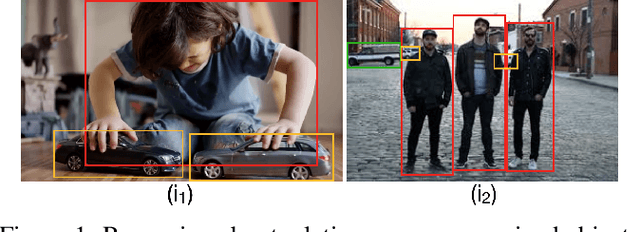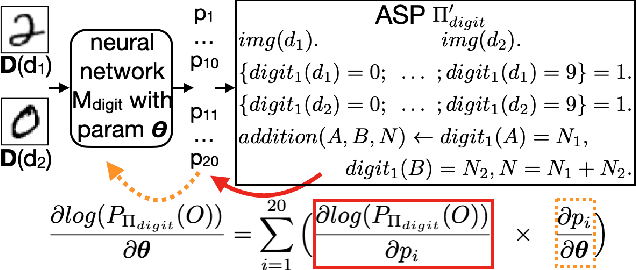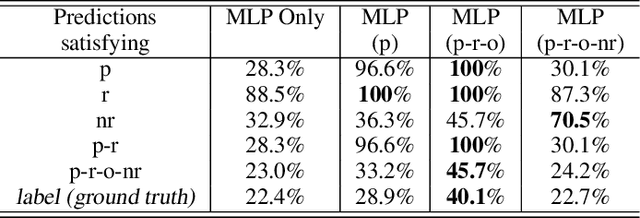Adam Ishay
Think before You Simulate: Symbolic Reasoning to Orchestrate Neural Computation for Counterfactual Question Answering
Jun 12, 2025Abstract:Causal and temporal reasoning about video dynamics is a challenging problem. While neuro-symbolic models that combine symbolic reasoning with neural-based perception and prediction have shown promise, they exhibit limitations, especially in answering counterfactual questions. This paper introduces a method to enhance a neuro-symbolic model for counterfactual reasoning, leveraging symbolic reasoning about causal relations among events. We define the notion of a causal graph to represent such relations and use Answer Set Programming (ASP), a declarative logic programming method, to find how to coordinate perception and simulation modules. We validate the effectiveness of our approach on two benchmarks, CLEVRER and CRAFT. Our enhancement achieves state-of-the-art performance on the CLEVRER challenge, significantly outperforming existing models. In the case of the CRAFT benchmark, we leverage a large pre-trained language model, such as GPT-3.5 and GPT-4, as a proxy for a dynamics simulator. Our findings show that this method can further improve its performance on counterfactual questions by providing alternative prompts instructed by symbolic causal reasoning.
LLM+AL: Bridging Large Language Models and Action Languages for Complex Reasoning about Actions
Jan 01, 2025



Abstract:Large Language Models (LLMs) have made significant strides in various intelligent tasks but still struggle with complex action reasoning tasks that require systematic search. To address this limitation, we propose a method that bridges the natural language understanding capabilities of LLMs with the symbolic reasoning strengths of action languages. Our approach, termed "LLM+AL," leverages the LLM's strengths in semantic parsing and commonsense knowledge generation alongside the action language's proficiency in automated reasoning based on encoded knowledge. We compare LLM+AL against state-of-the-art LLMs, including ChatGPT-4, Claude 3 Opus, Gemini Ultra 1.0, and o1-preview, using benchmarks for complex reasoning about actions. Our findings indicate that, although all methods exhibit errors, LLM+AL, with relatively minimal human corrections, consistently leads to correct answers, whereas standalone LLMs fail to improve even with human feedback. LLM+AL also contributes to automated generation of action languages.
Leveraging Large Language Models to Generate Answer Set Programs
Jul 15, 2023Abstract:Large language models (LLMs), such as GPT-3 and GPT-4, have demonstrated exceptional performance in various natural language processing tasks and have shown the ability to solve certain reasoning problems. However, their reasoning capabilities are limited and relatively shallow, despite the application of various prompting techniques. In contrast, formal logic is adept at handling complex reasoning, but translating natural language descriptions into formal logic is a challenging task that non-experts struggle with. This paper proposes a neuro-symbolic method that combines the strengths of large language models and answer set programming. Specifically, we employ an LLM to transform natural language descriptions of logic puzzles into answer set programs. We carefully design prompts for an LLM to convert natural language descriptions into answer set programs in a step by step manner. Surprisingly, with just a few in-context learning examples, LLMs can generate reasonably complex answer set programs. The majority of errors made are relatively simple and can be easily corrected by humans, thus enabling LLMs to effectively assist in the creation of answer set programs.
NeurASP: Embracing Neural Networks into Answer Set Programming
Jul 15, 2023



Abstract:We present NeurASP, a simple extension of answer set programs by embracing neural networks. By treating the neural network output as the probability distribution over atomic facts in answer set programs, NeurASP provides a simple and effective way to integrate sub-symbolic and symbolic computation. We demonstrate how NeurASP can make use of a pre-trained neural network in symbolic computation and how it can improve the neural network's perception result by applying symbolic reasoning in answer set programming. Also, NeurASP can be used to train a neural network better by training with ASP rules so that a neural network not only learns from implicit correlations from the data but also from the explicit complex semantic constraints expressed by the rules.
Coupling Large Language Models with Logic Programming for Robust and General Reasoning from Text
Jul 15, 2023Abstract:While large language models (LLMs), such as GPT-3, appear to be robust and general, their reasoning ability is not at a level to compete with the best models trained for specific natural language reasoning problems. In this study, we observe that a large language model can serve as a highly effective few-shot semantic parser. It can convert natural language sentences into a logical form that serves as input for answer set programs, a logic-based declarative knowledge representation formalism. The combination results in a robust and general system that can handle multiple question-answering tasks without requiring retraining for each new task. It only needs a few examples to guide the LLM's adaptation to a specific task, along with reusable ASP knowledge modules that can be applied to multiple tasks. We demonstrate that this method achieves state-of-the-art performance on several NLP benchmarks, including bAbI, StepGame, CLUTRR, and gSCAN. Additionally, it successfully tackles robot planning tasks that an LLM alone fails to solve.
Learning to Solve Constraint Satisfaction Problems with Recurrent Transformer
Jul 10, 2023



Abstract:Constraint satisfaction problems (CSPs) are about finding values of variables that satisfy the given constraints. We show that Transformer extended with recurrence is a viable approach to learning to solve CSPs in an end-to-end manner, having clear advantages over state-of-the-art methods such as Graph Neural Networks, SATNet, and some neuro-symbolic models. With the ability of Transformer to handle visual input, the proposed Recurrent Transformer can straightforwardly be applied to visual constraint reasoning problems while successfully addressing the symbol grounding problem. We also show how to leverage deductive knowledge of discrete constraints in the Transformer's inductive learning to achieve sample-efficient learning and semi-supervised learning for CSPs.
 Add to Chrome
Add to Chrome Add to Firefox
Add to Firefox Add to Edge
Add to Edge